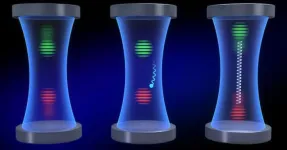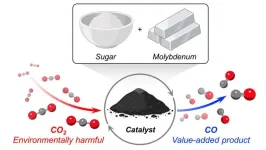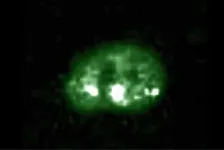(Press-News.org) Precisely measuring the energy states of individual atoms has been a historical challenge for physicists due to atomic recoil. When an atom interacts with a photon, the atom “recoils” in the opposite direction, making it difficult to measure the position and momentum of the atom precisely. This recoil can have big implications for quantum sensing, which detects minute changes in parameters, for example, using changes in gravitational waves to determine the shape of the Earth or even detect dark matter.
In a new paper published in the Science, JILA and NIST Fellows Ana Maria Rey and James Thompson, JILA Fellow Murray Holland, and their teams proposed a way to overcome this atomic recoil by demonstrating a new type of atomic interaction called momentum-exchange interaction, where atoms exchanged their momentums by exchanging corresponding photons.
Using a cavity—an enclosed space composed of mirrors—the researchers observed that the atomic recoil was dampened by atoms exchanging energy states within the confined space. This process created a collective absorption of energy and dispersed the recoil among the entire population of particles.
With these results, other researchers can design cavities to dampen recoil and other outside effects in a wide range of experiments, which can help physicists better understand complex systems or discover new aspects of quantum physics. An improved cavity design could also enable more precise simulations of superconductivity, such as in the case of the Bose-Einstein-Condensate-Bardeen-Cooper-Schrift (BEC-BCS) crossover or high-energy physical systems.
For the first time, the momentum-exchange interaction was observed to induce one-axis twisting (OAT) dynamics, an aspect of quantum entanglement, between atomic momentum states. OAT acts like a quantum braid for entangling different molecules, as each quantum state gets twisted and connected to another particle.
Previously, OAT was only seen in atomic internal states, but now, with these new results, it is thought that OAT induced by momentum exchange could help reduce quantum noise from multiple atoms. Being able to entangle momentum states could also lead to improvement in some physical measurements by quantum sensors, such as gravitational waves.
Leveraging a Density Grating
Within this new study, inspired by previous research from Thompson and his team, the researchers examined the effects of quantum superposition, which allows particles like photons or electrons to exist in multiple quantum states simultaneously.
“In this [new] project, the atoms all share the same spinlabel; the only difference is that each atom is in a superposition between two momentum states,” graduate student and first author Chengyi Luo explained.
The researchers found they could better control atomic recoil by forcing the atoms to exchange photons and their associated energies. Similar to a game of dodgeball, one atom may “throw” a “dodgeball” (a photon) and recoil in the opposite direction. That “dodgeball” may be caught by a second atom, which can cause the same amount of recoil for this second atom. This cancels out the two recoils experienced by both atoms and averages them for the entire cavity system.
When two atoms exchange their different photon energies, the resulting wave packet (an atom’s wave distribution) in superposition forms a momentum graph known as a density grating, which looks like a fine-toothed comb.
Luo added. “The formation of the density grating indicates two momentum states [within the atom] are ‘coherent’ with each other such that they could interfere [with each other].” The researchers found that the exchange of photons between atoms caused a binding of the two atoms’ wave packets, so they were no longer separate measurements.
The researchers could induce momentum exchange by exploring the interplay between the density grating and the optical cavity. Because the atoms exchanged energy, any recoil from absorbing a photon was dispersed among the entire community of atoms instead of individual particles.
Dampening the Doppler Shift
Using this new control method, the researchers found that they could also use this recoil-dampening system to help mitigate a separate measurement problem: the Doppler shift.
The Doppler shift, a phenomenon in classical physics, explains why the sound of a siren or train horn changes pitch as it passes a listener or why certain stars appear red or blue in night sky images—it’s the change in the frequency of the wave as the source and observer move toward (or away from) each other. In quantum physics, the Doppler shift describes a particle’s energy change due to relative motion.
For researchers like Luo, the Doppler shift can be a challenge to overcome in getting a precise measurement. “When absorbing photons, the atomic recoil will lead to a Doppler shift of the frequency of the photon, which is a big problem when you talk about precision spectroscopy,” he elaborated. By simulating their new method, the researchers found that it could overcome measurement skewing due to Doppler Shift.
Entangling Momentum Exchange
The researchers also found that the momentum exchange between these atoms could be used as a type of quantum entanglement. As John Wilson, a graduate student in the Holland group, elaborated: “As an atom falls, its motion wiggles the cavity frequency. That, in turn, encourages other atoms to collectively feel that feedback mechanism and nudges them to correlate their motion through the shared wobbles.”
To test this “entanglement” even further, the researchers created a bigger separation between the momentum states of the atoms and then induced the momentum exchange. The researchers found that the atoms continued to behave as if they were connected. “This indicates that the two momentum states are really oscillating concerning each other as if being connected by a spring,” added Luo.
Looking ahead, the researchers plan to probe this new form of quantum entanglement further, hoping to better understand how it can be used to improve various types of quantum devices.
This research was supported by the US Department of Energy, Office of Science,
National Quantum Information Science Research Centers, Quantum Systems Accelerator.
Written by Kenna Hughes-Castleberry, JILA Science Communicator
END
Twisting and binding matter waves with photons in a cavity
2024-05-02
ELSE PRESS RELEASES FROM THIS DATE:
Sugar-based catalyst upcycles carbon dioxide
2024-05-02
A new catalyst made from an inexpensive, abundant metal and common table sugar has the power to destroy carbon dioxide (CO2) gas.
In a new Northwestern University study, the catalyst successfully converted CO2 into carbon monoxide (CO), an important building block to produce a variety of useful chemicals. When the reaction occurs in the presence of hydrogen, for example, CO2 and hydrogen transform into synthesis gas (or syngas), a highly valuable precursor to producing fuels that can potentially replace gasoline.
With recent advances in carbon capture technologies, post-combustion carbon capture is ...
Deeper understanding of malaria parasite sexual development unlocks opportunities to block disease spread
2024-05-02
For the first time, the developmental stages of the deadliest human malaria parasite have been mapped in high resolution, allowing researchers to understand this ever-adapting adversary in more detail than previously possible.
The study, published today (2 May) in Science, details the critical developmental stages of the malaria parasite, Plasmodium falciparum, using single-cell RNA sequencing. This gives detailed information on the life stages of this parasite as it matures, changing from an asexual state to a sexual state, which is necessary before the parasite can be transmitted to mosquitoes.
The research from ...
Breaking ground: Investigating the long-term effects of early childhood education
2024-05-02
EMBARGOED TO 2:00 P.M. ET May 2, 2024
Contact: Patricia Lamiell; patricia.lamiell@tc.columbia.edu or Ari Morgan; teacherscollege@skdknick.com
Breaking Ground: Investigating the Long-Term Effects of
Early Childhood Education
New review from Teachers College, Columbia University, University of Virginia, University of California-Irvine, and University of Delaware Reveals Varied Impact of Preschool Programs on Long-Term School Success.
EDITOR’S NOTE: The EMBARGOED ...
Synchronization between the central circadian clock and the circadian clocks of tissues preserves their functioning and prevents ageing
2024-05-02
Barcelona, 2 May 2024 - Discovered in the 1970s, circadian clocks are essential for the regulation of biological time in most cells in the human body. These internal mechanisms adjust biological processes to a 24-hour cycle, allowing the synchronisation of cellular functions with daily variations in the environment. Circadian rhythms, which are coordinated by a central clock in the brain that communicates with clocks in different peripheral tissues, influence many functions, from our sleep patterns to our ability to metabolise food.
A team led by Dr. Salvador Aznar Benitah, an ICREA researcher ...
Physicists arrange atoms in extremely close proximity
2024-05-02
Proximity is key for many quantum phenomena, as interactions between atoms are stronger when the particles are close. In many quantum simulators, scientists arrange atoms as close together as possible to explore exotic states of matter and build new quantum materials.
They typically do this by cooling the atoms to a stand-still, then using laser light to position the particles as close as 500 nanometers apart — a limit that is set by the wavelength of light. Now, MIT physicists have developed a technique that allows them to arrange atoms in much closer proximity, down to a mere 50 nanometers. For context, a red blood cell ...
Scientists track ‘doubling’ in origin of cancer cells
2024-05-02
Working with human breast and lung cells, Johns Hopkins Medicine scientists say they have charted a molecular pathway that can lure cells down a hazardous path of duplicating their genome too many times, a hallmark of cancer cells.
The findings, published May 3 in Science, reveal what goes wrong when a group of molecules and enzymes trigger and regulate what’s known as the “cell cycle,” the repetitive process of making new cells out of the cells’ genetic material.
The findings could be used to develop therapies that interrupt snags in the cell cycle, ...
Human activity is causing toxic thallium to enter the Baltic sea, according to new study
2024-05-02
Woods Hole, Mass. (May 2, 2024) -- Human activities account for a substantial amount - anywhere from 20% to more than 60% - of toxic thallium that has entered the Baltic Sea over the past 80 years, according to new research by scientists affiliated with the Woods Hole Oceanographic Institution (WHOI) and other institutions.
Currently, the amount of thallium (element symbol TI), which is considered the most toxic metal for mammals, remains low in Baltic seawater. However, the research suggests that the amount of thallium could increase due to further anthropogenic, or human induced, activities, or due to natural or human re-oxygenation of the Baltic that could make the sea ...
NREL proof of concept shows path to easier recycling of solar modules
2024-05-02
The use of femtosecond lasers to form glass-to-glass welds for solar modules would make the panels easier to recycle, according to a proof-of-concept study conducted by researchers at the U.S. Department of Energy’s National Renewable Energy Laboratory (NREL).
The welds would eliminate the need for plastic polymer sheets that are now laminated into solar modules but make recycling more difficult. At the end of their useful lifespan, the modules made with the laser welds can be shattered. The glass and metal wires running through the solar cells can be easily recycled and the silicon ...
NREL invites robots to help make wind turbine blades
2024-05-02
Researchers at the U.S. Department of Energy’s National Renewable Energy Laboratory (NREL) have successfully leveraged robotic assistance in the manufacture of wind turbine blades, allowing for the elimination of difficult working conditions for humans and the potential to improve the consistency of the product.
Although robots have been used by the wind energy industry to paint and polish blades, automation has not been widely adopted. Research at the laboratory demonstrates the ability of a robot to trim, grind, and sand blades. Those necessary steps occur after the two sides of the blade are made using a mold ...
Scent sells – but the right picture titillates both eyes and nose, research finds
2024-05-02
Scented products with relevant images on their packaging and branding, such as flowers or fruit, are more attractive to potential customers and score better in produce evaluations, new research confirms.
And such images, the researchers conclude, are particularly effective if manufacturers and marketers choose pictures that are more likely to stimulate a stronger sense of the imagined smell – for example, cut rather than whole lemons. This, they say, suggests that as well as seducing our eyes, the images are stimulating our sense of smell.
The study, published online in the International Journal of Research in Marketing, could provide manufacturers and marketers ...



